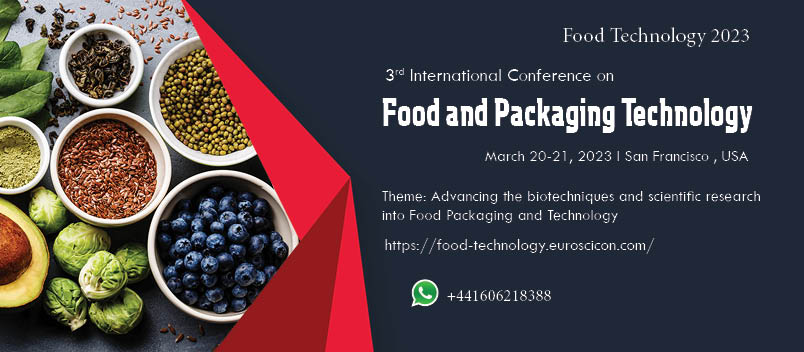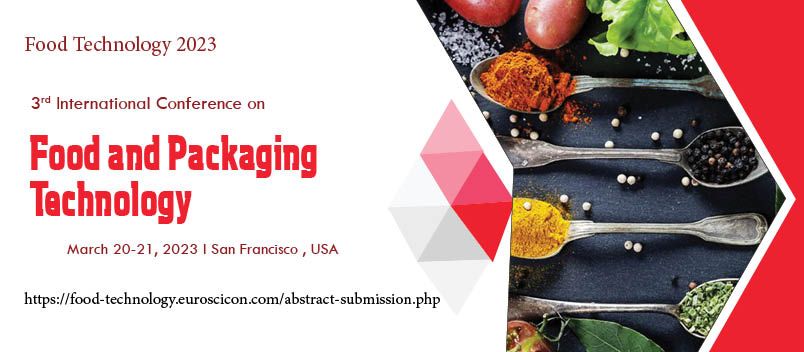FOOD TECHNOLOGY 2023
About Conference
SESSIONS AND TRACKS
Track 1: Food Innovations
Food innovations the concept of food innovation has been tossed around food companies with growing regularity in recent years. Most of the time, the term” innovation” is associated with new product development, but innovation can be applied equally well across corporate marketing, operations, quality assurance, food safety disciplines. No matter where innovation is applied, it always yields true value to the companies who embrace it properly and apply it to various departmental functions.
Track 2: Agriculture and its products
Agriculture is the science of cultivating plants, crops and raising animals for food and other benefits to humans. It is most important occupation in many countries and is the source for various industries. Researchers are continuously involved in identifying new techniques in farming to increase the crop yield within a specific time. Since there is a decrease in land for cultivation, introduction of effective techniques is the need of the hour.
Track 3: Meat production
The livestock sector has been undergoing fast pace over the last few years. The increasing demand for food derived from animals has led to large increases in livestock production, supported by major technological innovations and structural changes in the sector. This rising demand has been mostly met by commercial livestock production and associated food chains. At the same time, millions of rural people still keep livestock in traditional production systems, where they support livelihoods and household food security.
Track 4: Fish farming and fish products
Fish farming means, raising fish commercially in tanks, ponds or other enclosures for the purpose of producing food. Commercial fish farming has already established as a profitable business venture throughout the world. Fish is a great source of food and protein. The demand and price of fish and fish related products are also increasing rapidly, in accordance with rapid population growth. This is the main reason of increasing this business around the world. Almost all countries around the world are somehow suitable for fish farming business. But the countries with coastal areas are very suitable for this business. There are many areas, where fish farming business is the only way of livings for the people.
Track 5: Food processing
Food processing is the conversion of the raw ingredients into a consumable product using physical, chemical and biological means to increase its flavor, shelf life and for better nutritive value. Many food based industries are involved in processing of the food. Food processing includes mincing, macerating, liquefaction, pasteurization, pickling, canning and packaging. Processed foods are very common in these days and they are quite in higher demands.
Track 6: Food preservation
Food preservation is known as the science which deals with the process of prevention of decay or spoilage of food thus allowing it to be stored in a fit condition for future use. Preservation ensures that the quality, edibility and the nutritive value of the food remains intact. Preservation involves preventing the growth of bacteria, fungi and other microorganisms as well as retarding oxidation of fats to reduce rancidity. The process also ensures that there is no discoloration or aging. Preservation also involves sealing to prevent re-entry of microbes.
Track 7: Food engineering
Food engineering is a multidisciplinary field that combines science, microbiology and engineering strategies. It aims in providing technical knowledge for cost effective production and commercialization techniques to industries. Energy conservation, waste management and minimizing environmental hazards are also a major concern in Food engineering.
Track 8: Food microbiology
Microorganisms can be either harmful or useful in food processing techniques. Food microbiology is the science which includes the occurrence and significance of bacteria, fungi, protozoa and algae. Food processing involves the removal of pathogenic microorganisms from the food and also the use of microbes in fermentation for converting food to other form. Engineering microbes for secreting important enzymes in food processing is also being carried out in research areas.
Track 9: Food nanotechnology
Nanotechnology is having an impact on food science by different means, from production till package. Nano based companies are developing nanomaterial that will make a difference in the taste of food and also in the food safety, and the health benefits of food. Recent research has shown the useful applications of nanotechnology for functional foods and nutraceuticals by making use of the new concepts and engineering approaches involved in nanomaterials to for targeted delivery of micronutrients. It allow better encapsulation and release efficiency of the active food ingredients compared to traditional encapsulating agents, and the development of nano-emulsions, liposomes, micelles, biopolymer complexes and cubosomes have led to improved properties for bioactive compounds protection, controlled delivery systems, food matrix integration, and masking undesired flavors.
Track 10: Dairy Technology
Dairy Technology is deals with the processing of milk and its products. This field involves the use of “Technology” to make the dairy products and processing more advanced, hi-tech and useful. It is a component of food technology that specifically deals with the processing, storage, packaging, distribution and transportation of the dairy products like milk, ice-cream, curd etc by implying the science of biochemistry, bacteriology, nutrition to the milk and milk products.
Track 11: Food Immunology
The immune system of the body keeps you healthy by fighting off infections and other hazards to our health. A food allergy reaction occur when your immune system overreacts to a food or a substance in a food, identifying it as a danger and triggering a protective response. Symptoms of a food allergy can range from mild to severe. Just because an initial reaction causes few problems doesn’t mean that all reactions will be similar; a food that triggered only mild symptoms on one occasion may cause more severe symptoms at another time.
Track 12: Engineered microbes
The application of modern biotechnology to food production presents new opportunities and challenges for human health and development. Recombinant gene technology, the most well-known modern biotechnology, enables plants, animals and microorganisms to be genetically modified (GM) with novel traits beyond what is possible through traditional breeding and selection technologies.
Track 13: Bioprocess Engineering
Bioprocess engineering also, biochemical engineering deals with the design and development of equipment used in industries for various food processing techniques. It is a conglomerate of biology, mathematics and industrial design. It aims in obtaining high yield of end products with better quality. It includes Bioprocess engineering is a specialisation of chemical engineering; it deals with the design and development of equipment and processes for the manufacturing of products such as agriculture, food, feed, pharmaceuticals, nutraceuticals, chemicals and polymers and paper from biological material and treatment of waste water. Expertise in this field is a combination of knowledge in biotechnology and engineering. Bioprocess engineers develop concept technologies in the bioprocess space – anything that takes into account producing a product from biological material such as yeast, fungi, bacteria, algae, viruses, mammalian cells or any type of biological single cell process.
Track 14: Kinetics of Food process
The purpose of kinetics is important in many aspects of food research. Enzymatic, chemical, physical and microbial reactions in foods occur simultaneously during processing and storage, and usually it is a chain of reactions. Optimizing the quality of food in a quantitative way can be done with the proper use of kinetics. Furthermore, the food process engineer needs kinetics in order to optimize processes. In addition, kinetic modeling is also useful for the nutritionist, to study the kinetics of changes during digestion and assimilation in the body (bioavailability).
Track 15: Food chemistry
Food chemistry is the study of chemical process and interaction between the biological and non-biological components present in the food. It is similar to biochemistry that involves carbohydrates, lipids, proteins, water, vitamins, minerals, enzymes, food additives and flavor. It encompasses how food changes during processing techniques and the ways to prevent it from happening. Food chemistry involves the study and development of food additives that can be used to preserve the quality of food or to modify its color, flavor, and taste. It is, thus, closely linked to food processing and preparation techniques.
Track 16: Food synergy
There is evidence that certain components in the foods and beverages we consume like minerals, vitamins and phytochemicals, fiber, and fats interact with each other to give our bodies extra disease protection and a higher level of health. This new nutritional concept is called food synergy. It general it is the interaction of food with body.
Track 17: Food additives
A food additive is any substance added to food. Legally, the term refers to "any substance the intended use of which results or may reasonably be expected to result directly or indirectly in its becoming a component or otherwise affecting the characteristics of any food." This definition includes any substance used in the production, processing, treatment, packaging, transportation or storage of food. Flavor enhancers are used in savory foods to enhance the existing flavor in the food. Food flavor enhancers are commercially produced in the form of instant soups, frozen dinners and snack foods etc. Flavor enhancers modify flavors in the food without contributing to any significant flavor of their own. Controlled quantities of these are safe but if ingested in large quantities, they may lead to high blood pressure or some allergies.
Track 18: Enzymes in food
Enzymes are crucial to your health as they enable your body to break down food components into usable nutrients. Your intestines and pancreas produce a wide variety of enzymes, and certain foods contain these beneficial constituents or contain bacteria that produce them. Certain foods are high in enzymes, too, though they're broken down during digestion. While certain cultures eat high-enzyme foods for the perceived benefit of boosting digestion, there's not much evidence to show that enzymes help. Several high-enzyme foods offer other benefits, though, so they're still worthwhile additions to your diet. Enzymes are also being used in food processing.
Track 19: Nutrition and Nutrition Therapy
It is a science that deals with the process of providing nutrients required by the body for growth and survival. These nutrients can be obtained through food. Our body is also capable of synthesizing some of the nutrients while the others have to be consumed through food. A food should be rich in nutrients in order to meet the requirements of the body. Less nutrition in the body leads to various diseases and hence affects the metabolism of the body. Nutritional Therapy is the application of nutrition science in the promotion of health and is relevant for individuals with chronic conditions, as well as those looking for support to enhance their health and wellbeing.
Track 20: Nutraceuticals
Nutraceuticals is a broad umbrella term that is used to describe any product derived from food sources with extra health benefits in addition to the basic nutritional value found in foods. They can be considered non-specific biological therapies used to promote general well-being, control symptoms and prevent malignant processes. Most often they are grouped in the following categories as dietary supplements, functional food, medicinal food and farmaceuticals.
Track 21: Foodborne diseases and treatment
A disease caused by consuming contaminated food or drink. Myriad microbes and toxic substances can contaminate foods. There are more than 250 known foodborne diseases. The majority is infections are caused by bacteria, viruses, and parasites. Other foodborne diseases are essentially poisonings caused by toxins, chemicals contaminating the food. All foodborne microbes and toxins enter the body through the gastrointestinal tract and often cause the first symptoms there.
Track 22: Food and human health
Over consumption or low intake of food can lead to imbalance in the body which will result in serious ailments. Apart from food borne microbes, diseases can also occur because of human lifestyle. Eating food without nutritive values is a junk to our body.
Track 23: Dietetics
Dietetics is the practice of integrating biochemical, physiological, social, and managerial concepts into the science of nutrition to achieve a healthy lifestyle. A degree in dietetics offers challenging and rewarding employment opportunities working in hospitals, long-term care facilities, public health agencies, food industry, research labs and more. Whether administering medical nutrition therapy in a health-care setting or directing food service operations, registered dietitians work toward the prevention and treatment of disease.
Track 24: Food safety and hygiene
Food safety describes the handling, preparation and storage of food preventing it from foodborne diseases. Food safety also includes the quality of the food being produced. Quality standards need to be achieved to make it a better product. It includes a number of routines that should be followed to avoid health hazards. It protects the consumers from various ill effects.
Track 25: Food packaging
Packaging has been defined in many ways. Packaging is the art, science and technology of preparing products for market. It is also can be defined as a product made from any material such as paper, glass, plastic, aluminum and wood that is used for the containment, protection, handling, delivery and presentation of goods from raw to processed goods. Packaging ensures safe delivery of the product to the ultimate consumer in good condition at minimal overall cost. It is a system capable of containing the goods that it remains safe and efficacious within its shelf life.
Track 26: Food quality standards
Food quality is an important food manufacturing requirement, because food consumers are susceptible to any form of contamination that may occur during the manufacturing process. Many consumers also rely on manufacturing and processing standards, particularly to know what ingredients are present, due to dietary, nutritional requirements or medical conditions. Besides ingredient quality, there are also sanitation requirements. It is important to ensure that the food processing environment is as clean as possible in order to produce the safest possible food for the consumer.
Track 27: Food waste management
Food waste is the food that is discarded or left uneaten. In any case, correct definitions are threatening, consistently described on a situational commence. Proficient bodies, including overall affiliations, state governments and secretariats may use their own specific definitions. It is difficult to treat or reuse since it contains irregular measures of sodium salt and clamminess, and is mixed with other waste in the midst of amassing. It is very important situation to reduce the food wastage and make it available to the unavailable before spoilage. Hence food recycling is essential to resolve this issue.
Market Analysis
Food Technology Market: Overview
Emerging food technology is innovating the way local restaurant food is sourced and distributed and creating growth opportunities for food technology or online delivery platforms as well internet kitchen in the market. This advancement in food technology or online delivery platforms is generating lots of opportunities for restaurants in the food ordering industry.
Consumers nowadays prefer ordering their favorite meal through online platforms, with unlimited access to the number of restaurants. Consumers also have the convenience of selection, customization and can order food from the restaurants based on ratings and reviews.
Due to the superior ease of accessibility of online food delivering platforms, the food technology market is growing at a faster pace. The food technology web platforms are highly adopted by consumers and are proliferating due to the increase in usage of smartphones and the internet.
These food technology platforms help restaurants in achieving customer reach and to earn additional revenue as well as improve their resource utilization. Food technology is the listing platform that helps restaurants in increasing the awareness about the business. With the changing lifestyle and high standard of living, consumers are mainly dependent on services that help them in saving time and offer convenience simultaneously.
The trends of food delivery have transformed profoundly, particularly in the ways many restaurants and food chains are generating revenue. The advertisement for food technology apps such as online food ordering and online grocery apps is an upcoming method of generating revenue.
The food technology companies are offering restaurants with a large customer traffic and in exchange of that the food technology companies take the transactional fee on ordering food online through the restaurants on their application, which helps them to increase their revenue.
Food Technology Market: Dynamics
The increasing penetration of the internet and usage of the smartphones are the primary factors driving the growth of the food technology market. Also, these food technologies are used as online food delivery platforms that help restaurants in increasing their customer reach and generate additional income. This is one of the factors driving the growth of the food technology market.
Many restaurants who have collaborated with food applications for delivering their services are unable to reach customers because of factors such as low ratings over the application and user reviews that may not be true.
Past Conference
PAST CONFERENCE REPORT - FOOD TECHNOLOGY 2022
4th Euroscicon Conference on Food Technology and Processing (Food Technology 2022) hosted by EuroSciCon Ltd took place at Holiday Inn Athens-Attica Airport West, Florida, USA during June 08-09, 2022. It was organized by Euroscicon Ltd and generous response was received from the Editorial Board Members of EuroSciCon Ltd Journals as well as from eminent scientists, talented researchers, and young student community. Researchers and students who attended from different parts of the world made the conference one of the most successful and productive events in 2022 from EuroSciCon Ltd. The three-day program witnessed thought provoking keynote and plenary presentations from experts in the field of Food Technology and Nutrition highlighting the theme, "Advancing the biotechniques and scientific research into Food Technology ".
The meeting was carried out through various sessions, in which the discussions were held on the following major scientific tracks:
- Food Innovations
- Agriculture And Its Products
- Meat Production
- Fish Farming And Fish Products
- Food Processing
- Food Preservation
- Food Engineering
- Food Microbiology
- Food Nanotechnology
- Dairy Technology
- Food Immunology
- Engineered Microbes
- Bioprocess Engineering
- Kinetics Of Food Process
- Food Chemistry
- Food Synergy
- Food Additives
- Enzymes In Food
- Nutrition And Nutrition Therapy
The highlights of the meeting were form the eminent keynote lectures from
- Sandra Poirier, USA
- Ondulla Toomer, USA
- Marco Pellegrini, Italy
- Rob te Bieseke, Switzerland
- Massimo Zonca, Italy
- Yiannis Kourkoutas, Greece
Food Technology 2022 played an important role in promoting multidisciplinary interactions between science and technology to enhance research in Food Technology and Processing. The program covered current and emerging research innovations in the field of Food Technology and Nutrition.
We would specially thank the Moderators of Food Technology 2019,George siragakis Director of food allergens Lab Greece for their contribution to the conference.
We are obliged to the various delegates from companies and institutes who actively took part in the discussions. We sincerely thank the Organizing Committee Members and Editorial board of Food Technology 2022 for their gracious presence and continuous support throughout the proceedings of this event. With the valuable feedback and generous response received from the participants of the event, EuroSciCon Ltd would like to announce the commencement of "3rd International Conference on Food and Packaging Technology" during March 20-21, 2023 San Francisco, USA Let us meet again @ Food Technology 2023





















